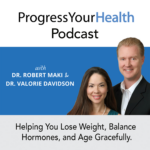

In this episode, we respond to Karen. Karen read an article of ours on BHRT and sent these concerns about her menopause and hormone dosages. We love Karen’s question because it shows how technical BHRT can be. As you will see from Karen’s question, there are multiple aspects to consider when treating a woman with hormones.
Karen’s Concerns:
Karen’s Question:
I am struggling to find the right dosage and combination of BHRT. I believe that I am sensitive to Progesterone. I am 53 and started menopause at age 50.
Hot flashes and weight gain are my two main symptoms (I was super thin my entire life, and now I’m 35 pounds overweight). I have 2-5 flashes a night not soaking, but they wake me (otherwise I would sleep fine) and always one at 4 or 5 am.
During the day I have several not unbearable but that is only while on BHRT (when I stopped taking everything it was brutal). I have been taking some form of BH for about 2 years now. I tried the patch Estradiol started at .5 and increased to .75mg.
My symptoms became tolerable, and the flashes were going away to the point that I only got the one early in the morning and maybe minor 1 or 2 during the day. But then I would take progesterone (pill) 100mg (and gradually tried to decrease).
As soon as I took the progesterone, the flashes would increase in intensity and frequency. I switched to cream currently taking a combined cream of 5mg estradiol/gm, 30 mg/gm of progesterone, 6 mg of testosterone/gm 1/4 gm applied once a day.
I still have difficulty losing weight, and flashes are still multiple times a night and throughout the day. (however, when I stop its 10 times worse). I’d like to switch to a biest and even cyclical dosing. I’ve read the Wiley protocol, but the dosing looks super high (at least to start).
I plan to stop the testosterone (I don’t have my numbers handy, but the testosterone wasn’t that bad) and may take DHEA instead. My estrogen levels were pretty much non-existent when I tested before starting BH. My progesterone levels were low but not horrific. I plan to test again after starting the new protocol (saliva hormones, urine metabolites, thyroid, etc ). Can you suggest a starting dose?
Should I do the biest at 50:50? How low can I go with progesterone and still have it protect me? I do want to do the cyclical dosing, and I have the rhythmic dosing protocol calendar, So any guidance is greatly appreciated. Also, if I want to use estriol vaginally (in addition) what dosage should I do for that? Do I need a script for that as well or can I order that online?
Our Response to Karen:
First, we wanted to address the progesterone. Progesterone is absolutely necessary if a woman has a uterus and she is taking estrogen. Estrogen likes to grow things, in particular, the uterine lining. But taking sufficient progesterone will help keep the lining thin reducing the risk for uterine cancer.
So if Karen has a uterus, she needs to take progesterone and ideally in a capsule/oral form. The oral forms of progesterone are more helpful at minimizing any growth of the uterine lining. But when Karen took the progesterone, she got terrible hot flashes. This happens in a small percentage of women. So then making sure her estrogen dose was high enough is important to help prevent these progesterone hot flashes.
Karen was on an estradiol patch at first. Remember when above when I said, estrogen likes to grow things. Well, estradiol, in particular, likes to do this, especially the waistline. Estradiol only in the form of a patch is pretty common for putting on about 8 lbs.
Now Karen had gained 35 lbs during menopause. Menopause itself is notorious for weight gain anyway. Then you add on an estradiol patch, over time Karen is going to continue to gain weight.
I do think Karen needs a Biest which is a combination of estradiol and estriol. Estriol is the most gentle of estrogens, and it helps balance some of the negative effects of estradiol. But when a woman has been on conventional hormone replacement such as estradiol patches or oral estradiol tablets, it is important to go pretty high on the biest dose, then work your way down. I cannot stress this enough.
I have had many women scoff at biest and say it doesn’t work. I won’t get into the physiology of the liver and body here. But when the body is used to stronger forms of estradiol only, you need to start high on the biest to get an effect. And trust me, biest is much safer with fewer side effects and better responded to than conventional estradiol only.
So I absolutely think Karen needs a higher dose of biest and at a 50:50 ratio. Her cream is 5 mg/gram biest, which the default ratio is 80:20. 80% estriol to 20% estradiol. That means her total 5mg of biest is 1 mg estradiol with 4 mg estriol.
But here is the key, she is only applying 1/4th gram once per day. 1/4th of a gram of 5mg (80:20) biest is equal to 1.25mg. Also equal to .25mg of estradiol and 1mg of estriol. This is an extremely low dose for a woman that was on an estradiol patch.
Switching Karen to a higher dose with a 50:50 ratio taken twice a day would be much better. Okay, so this is meant to be educational and not medical advice but I would have Karen take a 50:50 ratio of biest 8mg per gram. Taking ½ gram twice a day. That would equal 4 mg biest (2 mg estradiol/2 mg estriol) morning and again evening.
That would help the hot flashes, weight gain. And it would help her tolerate the 100-125 mg progesterone capsule that I think she would do well on. Then like Karen mentioned hold off on the testosterone. And here is another important part.
Have Karen test her levels in 6-9 weeks and follow up on the dose. We want to see how she is doing with her symptoms and health goals. Also, we want to see if her doses are being absorbed. I always recommend when testing for hormone levels, apply the hormone cream 3-5 hours prior to the test to check how much is being absorbed. Because I have women take their progesterone capsule only at night. It is okay to test the progesterone the next day. Then once her estradiol/estradiol and progesterone levels are set, add in the testosterone if needed.
Karen also mentions possibly trying the rhythmic cycling for hormones. The cream I was suggesting above is considered a static dose. Meaning the same amount is applied each day. With a rhythmic cycling dosage, the estradiol and progesterone cream doses change throughout the month. It is intended to mimic the natural estrogen and progesterone, 28-day cycle in a menstruating female. I will have to say, women either love this or hate it. When it works for a particular individual, it works well. BHRT is really an individualized art specific for that one person.
Yes, the rhythmic dosing consists of estradiol and progesterone creams typically. Although, I have some patients that I cycle the progesterone in capsule oral form that works great for them. Again, every woman is different. What works for one, may not work for someone else. So it is important as a physician to make sure to follow up with the patient on how they are responding to their BHRT dosing.
In further answering Karen’s concerns, she wanted to know about estriol vaginally. Estriol is fantastic for vaginal atrophy and vaginal dryness. You can find estriol over the counter, online or by prescription. To be completely honest, I am not familiar with all the OTC versions. Because there are specific vaginal cream forms that I use. And I like to know the exact dosage that a woman is applying. Usually, these are by prescription made at a compounding pharmacy.
There is one OTC form called Hydration Cubes that seem to work well for women vaginally. One thing to mention, even when a woman has the perfect dosage of hormones, she can still experience vaginal dryness. Using some form of estriol can be helpful. And again, this is not medical advice disclaimer thing to further answer Karen’s question, usually, 1-2 mg of estriol vaginally once to twice a week is usually sufficient.
So as you can see, there are a lot of aspects to BHRT dosing. Each woman has her own personal and family health history to take into consideration. As well as factoring in her own personal health goals and lab testing when forming her individualized BHRT regime. A great big shout out to Karen for sharing your concerns with us, so that it can possibly help others. If you have any questions you can leave a comment below or you can send an email to [email protected].
The post What Biest Ratio is Best for Menopause? | PYHP 052 appeared first on .
Discover the common and unfamiliar symptoms that you might be experiencing. Get access to cases of real women with hormonal conditions.

In this episode, we return to a listener’s question regarding thyroid dosing in perimenopause. In our previous episode, we answered Tracy’s question about taking estrogen in perimenopause. Tracy also asked us an additional question about her thyroid doses. Tracy does not have a thyroid gland and has been noticing her dose is continually increasing as […]
In this episode, we discuss a listener’s question regarding perimenopause and estrogen hormone replacement. Tracy is concerned because she is still having a period but also has symptoms of low estrogen. She is not sure if she is a candidate for estrogen therapy since she is still cycling. Tracy’s Question: Hi- you’ve discussed in past […]
In this episode we discuss Jenell’s question she submitted on our website (Ask the Dr). Jennell has been having terrible anxiety since entering menopause and it is really affecting her quality of life. Jenell’s Question: Since starting menopause, I’ve had debilitating anxiety, especially bad in the morning. By evening, It practically goes away. I’m 54 […]
In this episode, we discuss a listener’s question. Amanda is 50 years old and starting to have menopausal hot flashes and weight gain. However, she is most concerned about the heart palpitations she is having. Amanda has had a cardiovascular workout and does not have heart disease. Most people might not be aware, but feeling […]
In this episode, we discuss a listener’s question about perimenopause. ‘Maggie’ is in her 40’s and experiencing severe insomnia with anxiety. She has tried supplements and different doses of progesterone with minimal results. She is having so many ups and downs with her insomnia, anxiety, and hormones. She is wondering how long this is going […]
In this episode, we talk about Mary’s hormone concerns after ovarian failure. She is only 34, and in the last 7 years since her ovarian failure has tried many hormone replacement options, all without the success she was looking for. Let’s Read Mary’s Question: When I was 27 years old I was diagnosed with iatrogenic […]